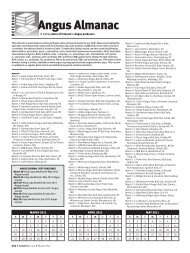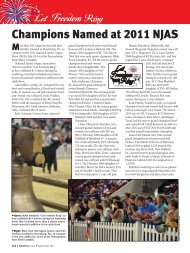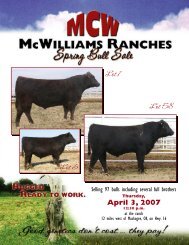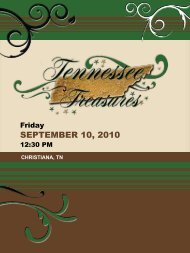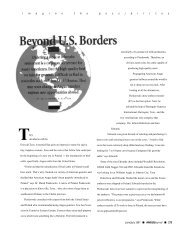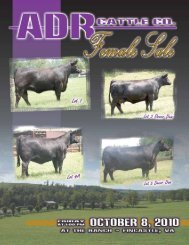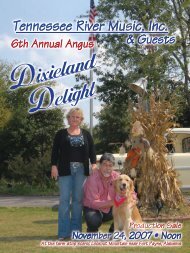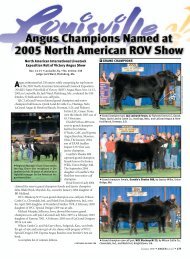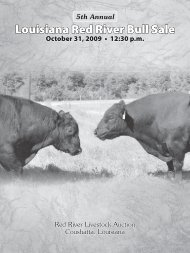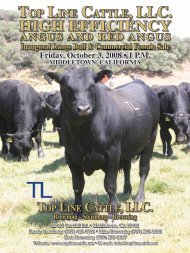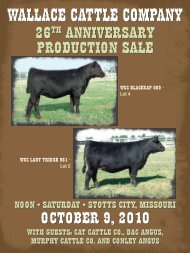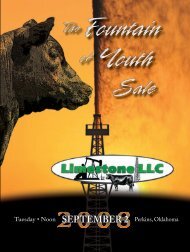Lydell Meier turns hard work into wins and earns ... - Angus Journal
Lydell Meier turns hard work into wins and earns ... - Angus Journal
Lydell Meier turns hard work into wins and earns ... - Angus Journal
Create successful ePaper yourself
Turn your PDF publications into a flip-book with our unique Google optimized e-Paper software.
@<strong>Lydell</strong> <strong>Meier</strong> (left), Cl<strong>into</strong>n, Tenn., receives the 2005 Herdsman of the Year Award from James Fisher,<br />
director of activities <strong>and</strong> junior activities for the American <strong>Angus</strong> Association.<br />
<strong>Lydell</strong> <strong>Meier</strong> <strong>turns</strong> <strong>hard</strong> <strong>work</strong> <strong>into</strong> <strong>wins</strong><br />
<strong>and</strong> <strong>earns</strong> the respect of his peers.<br />
@ <strong>Lydell</strong> considers fitting <strong>and</strong> clipping<br />
cattle an unteachable art. “It’s something<br />
you’ve just got to pick up on your<br />
own,” he says.<br />
Story & photos by Brooke Byrd<br />
Denver, Colo., <strong>and</strong> the National Western<br />
Stock Show (NWSS) have become<br />
something of a tradition for <strong>Lydell</strong> <strong>Meier</strong>,<br />
Cl<strong>into</strong>n, Tenn. In the fourth year he has<br />
attended the NWSS with Gamble <strong>Angus</strong>,<br />
<strong>Lydell</strong> won the 2005 Herdsman of the Year<br />
Award, voted upon by fellow <strong>Angus</strong> fitters<br />
<strong>and</strong> showmen.<br />
PHOTO BY SHELIA STANNARD<br />
“I was shocked,” <strong>Lydell</strong> says.“What makes<br />
me feel so good is that all the friends I’ve<br />
made across the country who didn’t know me<br />
from Adam three years ago voted for me <strong>and</strong><br />
have appreciated what I’ve been able to do.”<br />
What <strong>Lydell</strong> has been able to do in those<br />
three years is impressive. After joining up<br />
with Gamble <strong>Angus</strong>, <strong>Lydell</strong>’s management<br />
<strong>and</strong> strong <strong>work</strong> ethic have brought him<br />
from a few class winners at the 2002 NWSS<br />
to winning the Roll of Victory (ROV) bull<br />
show in 2003 to winning both the ROV bull<br />
<strong>and</strong> female shows in 2004. This year, his<br />
success was rewarded with admiration.<br />
“To have the success we’ve had at Denver<br />
<strong>and</strong> then for people — friends, peers <strong>and</strong><br />
competitors — to actually vote for me was<br />
incredible,” he says.<br />
The story begins<br />
<strong>Lydell</strong>, originally from Stonewall, Texas,<br />
was raised around show cattle.“I grew up<br />
knowing nothing but cows,” he says. His<br />
family raised Hereford cattle with a fitting<br />
service on the side. <strong>Lydell</strong> got his first taste of<br />
<strong>Angus</strong> when he showed some heifers in high<br />
school. While attending college at Texas Tech<br />
University, Lubbock, <strong>Lydell</strong> got even more<br />
involved with fitting <strong>and</strong> showing <strong>Angus</strong> by<br />
helping Doug Satree, Montague, Texas,<br />
His success story truly began in May 2001.<br />
While helping Doug at the Atlantic National<br />
ROV show, <strong>Lydell</strong> met his future wife, Holly<br />
Gamble (now Holly <strong>Meier</strong>).“We happened<br />
to meet <strong>and</strong> hit it off immediately,” he says.<br />
Holly, her father, John, <strong>and</strong> brother, Ben,<br />
operated Gamble <strong>Angus</strong>. In 2001, the<br />
operation was very small, with only 25-30<br />
cows.“Holly <strong>and</strong> her dad were trying to do<br />
things with the cattle, but they were so<br />
involved with their funeral home business<br />
that they just weren’t getting done what they<br />
wanted to,” <strong>Lydell</strong> says. Since he was<br />
frustrated with his job as a bank loan officer,<br />
<strong>Lydell</strong> <strong>and</strong> Holly made a deal.<br />
“If I took over their cattle operation, that<br />
would allow her <strong>and</strong> her dad more time to<br />
concentrate on the family business,” he says.<br />
The Gambles had gathered a good genetic<br />
foundation. <strong>Lydell</strong> re<strong>work</strong>ed the breeding<br />
scheme <strong>and</strong> nutritional program, <strong>and</strong><br />
created a show program.“We just blossomed<br />
from there,” he says.<br />
Changing for the better<br />
Now married <strong>and</strong> with a young son,<br />
Tristan Andrew, <strong>Lydell</strong> has helped increase<br />
the herd to approximately 150 purebred<br />
<strong>Angus</strong> <strong>and</strong> commercial recipient females.<br />
218 n ANGUS<strong>Journal</strong> n March 2005
Cows calve from January to May to have<br />
different-aged show heifers, <strong>and</strong> there are<br />
usually at least 20 show cattle in the barn to<br />
be <strong>work</strong>ed every day.<br />
“Since <strong>Lydell</strong> came up here, our numbers<br />
have increased <strong>and</strong> the quality of our cattle<br />
has improved dramatically,” Holly says. In the<br />
past Gamble <strong>Angus</strong> sold cattle mainly at local<br />
consignment sales, but with <strong>Lydell</strong>’s<br />
marketing talents, she says,“we’ve moved a<br />
lot of cattle throughout the U.S.”<br />
With a more efficient breeding schedule<br />
<strong>and</strong> increasing use of embryo transfer (ET),<br />
Holly says <strong>Lydell</strong> has enabled Gamble <strong>Angus</strong><br />
to build upon its strong foundation in a way<br />
she <strong>and</strong> her father never had enough time<br />
to do.<br />
Gamble <strong>Angus</strong> has thrived in the showring<br />
due to <strong>Lydell</strong>’s direction <strong>and</strong> management.<br />
“Before, most of the cattle that we would win<br />
with in the ring were cattle that we had<br />
bought. Now most of the ones we take on the<br />
road are ones we’ve actually raised,” Holly<br />
says, adding they’re taking more numbers to<br />
shows now.“<strong>Lydell</strong> does such a good job<br />
feeding <strong>and</strong> getting them ready, <strong>and</strong> in the<br />
way the cattle are presented in general.”<br />
<strong>Lydell</strong> is able to give the ranch the attention<br />
that it needs to succeed, Holly continues.“His<br />
number one priority is the cattle. He <strong>work</strong>s<br />
from seven in the morning to 10 at night<br />
during the summertime,” she says.“Instead of<br />
giving 99%, he’s always giving 110% when it<br />
comes to the cattle, the farm <strong>and</strong> our partners.<br />
He’d do anything for anybody.”<br />
True <strong>work</strong> ethic<br />
One of the main things that struck Doug<br />
about <strong>Lydell</strong> was his drive.“I could tell he<br />
was going to succeed, because he had that<br />
want-to <strong>and</strong> he had the desire,” he says.<br />
“He’s very versatile, very ubiquitous in<br />
anything you need him to do,” he continues,<br />
“whether it’s sticking, leading cattle, washing<br />
— anything from the most menial thing to<br />
the most intensive thing.”<br />
Doug says Gamble <strong>Angus</strong> had a<br />
tremendous amount of promise <strong>and</strong> cow<br />
power, but <strong>Lydell</strong> helped put things on the<br />
right path.“He had the <strong>work</strong> ethic <strong>and</strong> the<br />
desire to take those cattle <strong>and</strong> develop them<br />
<strong>and</strong> hit that show road,” he says.<br />
Among those he has <strong>work</strong>ed for <strong>and</strong> those<br />
he has <strong>work</strong>ed with in the barns, <strong>Lydell</strong> is<br />
known as an expert fitter.“He knows cattle<br />
real well, <strong>and</strong> he knows how they’re<br />
supposed to look,” Doug says. In a show<br />
world where judges’ preferences can range<br />
widely, <strong>Lydell</strong> is able to adapt, Doug says.<br />
“Change is always <strong>hard</strong> for<br />
anybody, but he can see that, <strong>and</strong><br />
whether he likes it or not, he<br />
realizes that’s where it needs to go,<br />
that’s how they need to look <strong>and</strong><br />
that’s how we’re going to make<br />
them look.”<br />
Bruce <strong>and</strong> Amie Stertzbach,<br />
Louisville, Ohio, say they believe<br />
<strong>Lydell</strong> was voted Herdsman<br />
because of the extreme effort that<br />
he offers. Competitors in the<br />
showring <strong>and</strong> friends of <strong>Lydell</strong> <strong>and</strong> Holly in<br />
the barns, Bruce <strong>and</strong> Amie say <strong>Lydell</strong> wants<br />
to be the best at what he does.“He gives the<br />
effort to get it done,” Bruce says.“Some<br />
people just go through the motions. He gives<br />
24-hours-a-day effort to this.<br />
“You have to breed good cattle, but then<br />
you have to take care of them right,” he<br />
continues.“<strong>Lydell</strong> lives <strong>and</strong> breathes the<br />
cattle business. Some people do it as a parttime<br />
thing — it’s everything to him.”<br />
Bruce says that it takes time to earn the<br />
Herdsman Award, <strong>and</strong> <strong>Lydell</strong> has spent his<br />
time wisely.“He’s shown the ability to<br />
compete with the best <strong>and</strong> shows them at<br />
every show that he can have those cattle at 12<br />
o’clock, <strong>and</strong> that <strong>earns</strong> the respect of people<br />
in the barns.”<br />
“You can’t just care about it when you’re at<br />
the show. It starts from Day 1 when you’re at<br />
home <strong>and</strong> <strong>work</strong>ing the 10 to 12 hours that it<br />
takes every single day,” Amie explains.“He’s<br />
proved that he’s done it at home, <strong>and</strong> it pays<br />
off when he gets to the shows.<br />
“If something isn’t quite right at the last<br />
show you were at,” she says,“on your drive<br />
home the first thing you think of is how to<br />
fix it <strong>and</strong> make it better. You take them<br />
seriously when you find out they’re in your<br />
class, because you know that’s where a lot of<br />
your competition is going to come from.”<br />
The road to success<br />
Before he does anything with his cattle,<br />
<strong>Lydell</strong> relies on his ability to envision the<br />
future.“You have to evaluate cattle when<br />
they’re young. I try to take a mental picture<br />
of what I think they can <strong>and</strong> what they could<br />
look like if I do certain things to them,” he<br />
says.“You’ve got to know what that end<br />
product’s going to look like before you ever<br />
start.”<br />
When he does start, <strong>Lydell</strong> focuses heavily<br />
on nutrition <strong>and</strong> hair <strong>and</strong> skin care, the<br />
knowledge of which he attributes to Doug<br />
<strong>and</strong> to his father.“When you get them on the<br />
right program <strong>and</strong> the right nutrition <strong>and</strong><br />
@ <strong>Lydell</strong>’s son attended his first NWSS in 2005.<br />
When accepting his award, <strong>Lydell</strong> remarked that<br />
Denver had become a tradition for him, <strong>and</strong> he<br />
hoped it would be for his son also. Pictured are<br />
(from left) Holly, <strong>Lydell</strong> <strong>and</strong> Tristan Andrew <strong>Meier</strong>.<br />
you do the right things to them,” he says,<br />
“you can take an average one <strong>and</strong> make it<br />
meet its genetic potential.”<br />
In the first two years he <strong>work</strong>ed with<br />
Gamble <strong>Angus</strong>, <strong>Lydell</strong> <strong>and</strong> Holly would stay<br />
out in the barn until 9 or 10 p.m., just<br />
<strong>work</strong>ing hair. Even now, he washes <strong>and</strong> rinses<br />
the show cattle every day <strong>and</strong> pays close<br />
attention to individual animals’ hair care<br />
needs.“It’s just a daily thing,” he says.“If they<br />
have a little bit of d<strong>and</strong>ruff, you just change<br />
something else until you get it right.”<br />
<strong>Lydell</strong> lives by two lessons learned from<br />
his father: (1) success takes an extreme<br />
amount of <strong>work</strong>, <strong>and</strong> (2) the only things in<br />
life that you can ever call your own are the<br />
things you earn yourself.<br />
“To have that extra-special look at shows<br />
<strong>and</strong> stay fresh, to really be on top of the<br />
game, it takes a lot of time <strong>and</strong> a lot of <strong>work</strong>,”<br />
<strong>Lydell</strong> says. Luckily for Gamble <strong>Angus</strong> <strong>and</strong><br />
<strong>Lydell</strong>, that’s exactly what he loves to do.<br />
“We’ve got to <strong>work</strong> <strong>hard</strong>er <strong>and</strong> longer <strong>and</strong><br />
better than everybody else if we’re going to<br />
try to make a splash in this deal,” he says.<br />
CONTINUED ON PAGE 220<br />
@In 2005, the first year Gamble <strong>Angus</strong> ever<br />
brought cattle to the yards, their pen won its division.<br />
<strong>Lydell</strong> considers Denver the Superbowl of all<br />
shows <strong>and</strong> tries to have his cattle in peak condition.<br />
March 2005 n ANGUS<strong>Journal</strong> n 219
A True Success Story<br />
CONTINUED FROM PAGE 219<br />
“The guys that help me hate the fact that<br />
we’ve got lights around the barn.”<br />
<strong>Lydell</strong> is quick to note that Gamble <strong>Angus</strong><br />
is operated by a team. Ben helps when he<br />
can, John hays <strong>and</strong> does all the artificial<br />
insemination (AI) <strong>work</strong>, <strong>and</strong> “Holly could<br />
replace about two or three guys at the<br />
shows,” he says.<br />
He also emphasizes the important roles<br />
that friends <strong>and</strong> luck have played in his<br />
success. He gives thanks to Bruce <strong>and</strong> Amie<br />
for helping Holly <strong>and</strong> John build a strong<br />
group of cows to found the show program.<br />
The motto that the only things in life you<br />
can call your own are the things you earn<br />
yourself reflects one of the main reasons<br />
<strong>Lydell</strong> loves the showring, as well as his<br />
competitive nature. “It’s a way that you can<br />
judge your <strong>work</strong> at home versus how<br />
everybody else does it,” he says. “If your<br />
cattle look better than everybody else’s at the<br />
show, you know you’re doing something<br />
extra special at home that’s above <strong>and</strong><br />
beyond everybody else.”<br />
<strong>Lydell</strong> also believes the showring is one of<br />
the best ways to advertise the ranch <strong>and</strong> its<br />
genetics. When people notice how much<br />
<strong>work</strong> you put <strong>into</strong> your cattle, he says,“they’re<br />
going to want to buy cattle from you.”<br />
Shifting perspectives<br />
<strong>Lydell</strong> has come away from the showring<br />
with a different perspective than when he<br />
started.“Used to be that if you didn’t win,<br />
everything was lost, but now it’s not,” he says.<br />
“You’ve got to be able to take whatever you<br />
get <strong>and</strong> go home <strong>and</strong> build from it.”<br />
He has strong hopes <strong>and</strong> goals for Gamble<br />
<strong>Angus</strong>.“I want to be able to produce cattle<br />
that are so phenotypically superior <strong>and</strong> sound<br />
that when people mention buying <strong>Angus</strong><br />
cattle, the first name that pops in their minds<br />
is our farm’s name,” he says.“I want every calf<br />
that we wean to have the potential of being<br />
shown, because if you can get that type of<br />
quality in numbers, then you know that your<br />
breeding program is really going well.”<br />
In focusing on producing show cattle,<br />
<strong>Lydell</strong> is also focusing on helping out an<br />
important group.“Our whole program is<br />
geared toward the juniors, <strong>and</strong> we help them<br />
as much as humanly possible,” he says.“It’s<br />
two ex-juniors trying to raise cattle for<br />
juniors now.”<br />
His perspectives have also shifted to<br />
another <strong>Angus</strong> junior, his <strong>and</strong> Holly’s young<br />
son.“Ever since he’s been born I find myself<br />
leaving the house a little later, <strong>and</strong> I get in a<br />
little earlier,” he says.“Now the gear of the<br />
program <strong>and</strong> our success is going to be more<br />
focused toward him.”<br />
With plans for building a small cow herd<br />
of his son’s own, <strong>Lydell</strong> says that when he’s<br />
old enough, he should be ready to jump <strong>into</strong><br />
the showring.<br />
“He’s got about two options,” he says.“If<br />
he’s not going to be showing cattle, he’d<br />
better be playing football.”<br />
220 n ANGUS<strong>Journal</strong> n March 2005




